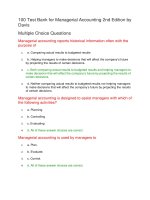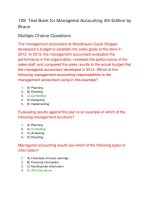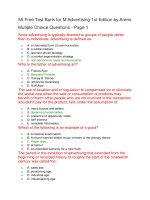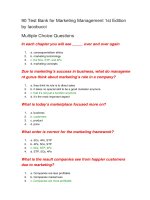Test bank for managerial accounting 1st edition by oliver
Bạn đang xem bản rút gọn của tài liệu. Xem và tải ngay bản đầy đủ của tài liệu tại đây (193.95 KB, 30 trang )
Test Bank for Managerial Accounting 1st Edition by Oliver
Managerial accounting’s focus is to provide information for internal planning and control.
1. True
2. False
Management accounting often requires forward-looking data because of the futuristic nature of
manybusiness decisions.
1. True
2. False
Management accounting is influenced significantly by the Securities Exchange Commission.
1. True
2. False
Budget preparation is a part of the planning process.
1. True
2. False
Financial accounting and managerial accounting both utilize the accrual basis of
accounting.
1. True
2. False
Which of the following is NOT an objective of management accounting?
1. A) To provide information to business managers to assist them in planning for their
business
2. B) To provide information to business managers to assist them in controlling their
business
3. C) To provide information to shareholders to assist them with their investment
decisions
4. D) To assist business managers with respect to providing a return to the owners of the
business
Which of the following statements is incorrect?
1. A) The primary users of management accounting are the company’s managers.
2. B) Management accounting information is used to help managers plan and control
their operations.
3. C) Management accounting information does not require an external audit.
4. D) Management accounting’s financial reports are restricted by generally accepted
accounting principles.
Which of the following types of accounting is designed to meet the needs of decision-makers
inside a company?
1. A) Financial accounting
2. B) Tax accounting
3. C) Management accounting
4. D) Auditing
Which statement is correct?
1. A) Management accounting uses the cash basis and financial accounting uses the
accrual basis to record transactions.
2. B) Management accounting uses the cash basis to record transactions.
3. C) Financial accounting uses the cash basis to record transactions.
4. D) Both management accounting and financial accounting use the accrual basis to
record transactions.
Which of the following statements is incorrect?
1. A) Management uses accounting information to determine the cost of products and
services.
2. B) Management uses accounting information to plan and control business operations.
3. C) Management uses accounting information to report the company's financial
position and results of operations to external parties.
4. D) Financial accounting is more relevant to use for internal decision making purposes
than is management accounting.
Which of the following statements about financial accounting is correct?
1. A) Financial accounting helps investors make decisions.
2. B) Financial accounting reports do not influence investor behavior.
3. C) Financial provides detailed reports on parts of the company.
4. D) Financial accounting provides help in planning and controlling operations.
Which of the following statements about managerial accounting is correct?
1. A) Managerial accounting reports are audited annually by Certified Public
Accountants.
2. B) Managerial accounting reports help investors make decisions.
3. C) Managerial accounting reports provide detailed information on parts of a company.
4. D) Managerial accounting reports must follow Generally Accepted Accounting
principles (GAAP).
Which of the following reports must be audited by certified public accountants?
1. A) Annual financial reports
2. B) Federal tax returns
3. C) State tax returns
4. D) Management accounting reports
During the past century, many developed economies have shifted their focus from a service
economy to a manufacturing economy.
1. True
2. False
Increased global competition has resulted in many companies moving their operations to other
countries to be closer to new markets.
1. True
2. False
Which of the following is a philosophy of providing customers with superior products and
services?
1. A) Just-in-time (JIT)
2. B) ERP
3. C) Supply chain management
4. D) Total quality management
Which of the following describes a system in which suppliers deliver materials at the time they
are needed and finished units are completed when customer orders need to be filled?
1. A) Supply chain management
2. B) Just-in-time (JIT)
3. C) Enterprise resource planning
4. D) Total quality management
What is total quality management?
1. A) A philosophy of supplying customers with superior products and services
2. B) An exchange of information with suppliers and customers to create efficient and
effective processes
3. C) A software system that integrates a company's functions, departments and data
into a single system
4. D) A system in which a company produces what it needs when it needs it
What is the name given to software systems that can integrate all of a company's worldwide
functions, departments and data into a single system?
1. A) All in One Software
2. B) Enterprise Resource Planning
3. C) Total Integrated Software
4. D) Just-in-time
Period costs, such as direct materials, are expensed during the period that they were
incurred.
1. True
2. False
A service company’s income statement does NOT include cost of goods sold.
1. True
2. False
Which of the following costs do NOT go directly into the work in process account?
1. A) Factory overhead
2. B) Indirect labor
3. C) Factory janitorial costs
4. D) The purchase of raw materials
Which of the following are period costs?
1. A) Current assets on the balance sheet
2. B) Costs incurred and expensed during the accounting period
3. C) Costs related to the manufacture of products
4. D) Current liabilities on the balance sheet
Which of the following is a characteristic of a service company?
1. A) It transforms raw materials into finished goods.
2. B) It makes a product.
3. C) It does not have tangible products intended for sale.
4. D) It has a single category of inventory.
Which of the following is an example of a period cost?
1. A) Advertising expense
2. B) Depreciation on factory equipment
3. C) Indirect materials
4. D) Property taxes on plant
Which of the following could be found on the income statement of a service company?
1. A) Rent expense
2. B) Cost of goods manufactured
3. C) Cost of goods sold
4. D) Manufacturing overhead
Which of the following statements is correct?
1. A) A decrease in finished goods means that cost of goods manufactured is greater
than cost of goods sold.
2. B) A decrease in work in process means that cost of goods sold is greater than cost of
goods manufactured.
3. C) A decrease in raw materials implies that the cost of materials used in production
exceeds the cost of the materials purchased.
4. D) A decrease in work in process means that cost of goods manufactured was less
than the manufacturing costs incurred.
Which of the following is an inventory account for a merchandise company?
1. A) Work in process inventory
2. B) Manufacturing overhead inventory
3. C) Merchandise inventory
4. D) Finished goods inventory
Which of the following costs would appear on the income statements for both a merchandiser
and a manufacturer?
1. A) Direct labor incurred
2. B) Cost of goods manufactured
3. C) Direct materials used
4. D) Operating expenses
A merchandiser's purchases are equivalent to what for a manufacturer?
1. A) Materials inventory
2. B) Cost of goods manufactured
3. C) Work in process inventory
4. D) Cost of goods sold
The following information pertains to Bright Toy Company's operating activities for 2009. The
company sells light box toys and sold 10,000 units in 2009. Purchases $ 126,000 Selling and
Administrative Expenses 90,000 Merchandise inventory, 1/1/2009 14,000 Merchandise inventory,
12/31/2009 10,000 Sales Revenue 250,000 What is the cost of goods available for sale for
2009?
1. A) $140,000
2. B) $126,000
3. C) $104,000
4. D) $130,000
The following information pertains to Bright Toy Company's operating activities for 2009. The
company sells light box toys and sold 10,000 units in 2009. Purchases $ 126,000 Selling and
Administrative Expenses 90,000 Merchandise inventory, 1/1/2009 14,000 Merchandise inventory,
12/31/2009 10,000 Sales Revenue 250,000 What is the cost of goods sold for 2009?
1. A) $104,000
2. B) $124,000
3. C) $130,000
4. D) $140,000
The following information pertains to Bright Toy Company's operating activities for 2009. The
company sells light box toys and sold 10,000 units in 2009. Purchases $ 126,000 Selling and
Administrative Expenses 90,000 Merchandise inventory, 1/1/2009 14,000 Merchandise inventory,
12/31/2009 10,000 Sales Revenue 250,000 What is the gross profit for 2009?
1. A) $120,000
2. B) $130,000
3. C) $140,000
4. D) $136,000
The following information pertains to Bright Toy Company's operating activities for 2009. The
company sells light box toys and sold 10,000 units in 2009. Purchases $ 126,000 Selling and
Administrative Expenses 90,000 Merchandise inventory, 1/1/2009 14,000 Merchandise inventory,
12/31/2009 10,000 Sales Revenue 250,000 What is the operating income for 2009?
1. A) $250,000
2. B) $140,000
3. C) $30,000
4. D) $90,000
The following information pertains to Bright Toy Company's operating activities for 2009. The
company sells light box toys and sold 10,000 units in 2009. Purchases $ 126,000 Selling and
Administrative Expenses 90,000 Merchandise inventory, 1/1/2009 14,000 Merchandise inventory,
12/31/2009 10,000 Sales Revenue 250,000 What is the profit margin percentage?
1. A) 12%
2. B) 56%
3. C) 100%
4. D) 36%
The following information pertains to Bright Toy Company's operating activities for 2009. The
company sells light box toys and sold 10,000 units in 2009. Purchases $ 126,000 Selling and
Administrative Expenses 90,000 Merchandise inventory, 1/1/2009 14,000 Merchandise inventory,
12/31/2009 10,000 Sales Revenue 250,000 What is the gross profit percentage?
1. A) 48%
2. B) 56%
3. C) 36%
4. D) 100%
The following information pertains to Bright Toy Company's operating activities for 2009. The
company sells light box toys and sold 10,000 units in 2009. Purchases $ 126,000 Selling and
Administrative Expenses 90,000 Merchandise inventory, 1/1/2009 14,000 Merchandise inventory,
12/31/2009 10,000 Sales Revenue 250,000 What is the cost per light box sold in 2009?
1. A) $13.00
2. B) $12.40
3. C) $14.00
4. D) $10.40
GAAP requires companies to treat product costs such as factory overhead as an asset until the
product is sold.
1. True
2. False
Cost of goods manufactured includes direct materials, direct labor, and manufacturing
overhead.
1. True
2. False
Manufacturing overhead includes all manufacturing costs such as direct labor and direct
materials.
1. True
2. False
Manufacturing overhead includes indirect costs such as insurance and depreciation on the
factory building.
1. True
2. False
A manufacturer’s inventory consists of raw materials, work in process, and finished goods.
1. True
2. False
An increase in finished goods inventory implies that cost of goods sold was greater than cost of
goods manufactured.
1. True
2. False
Selling and administrative expenses are subtracted from cost of goods sold to obtain operating
income.
1. True
2. False
An increase in the work in process account during the year means that cost of goods
manufactured was greater than the manufacturing costs incurred during the year.
1. True
2. False
The costs of indirect materials cannot easily be traced to the manufactured product and is
therefore a component of manufacturing overhead.
1. True
2. False
The total manufacturing costs to account for during the year minus the beginning work in process
equals cost of goods manufactured.
1. True
2. False
Which of the following statements does NOT describe today’s business environment?
1. A)The business environment is shifting toward a service economy.
2. B) Global competition requires businesses to adjust their business strategies.
3. C) E-commerce has allowed business managers the opportunity to slow down the
their manufacturing and delivery times.
4. D) Enterprise resource planning systems have emerged to assist business manager
with respect to
5. integrating their worldwide functions.
A service company’s:
1. A) expenses are all period costs.
2. B) expenses are all product costs.
3. C) income statement includes gross margin.
4. D) balance sheet includes finished goods inventory.
A merchandising company’s:
1. A) expenses include both period costs and product costs.
2. B) expenses include only product costs.
3. C) expenses include only period costs.
4. D) income statement doesn’t include gross margin.
Which of the following is NOT a part of manufacturing overhead?
1. A) Indirect materials
2. B) Indirect labor
3. C) Factory insurance
4. D) Depreciation on delivery vehicles
Which of the following is NOT a product cost?
1. A) Indirect labor
2. B) Factory overhead
3. C) Indirect materials
4. D) Depreciation of corporate headquarters
Period costs do NOT include which of the following?
1. A) Sales commissions
2. B) Factory janitorial costs
3. C) Insurance on delivery vehicles
4. D) Advertising costs
Inventory accounts for a manufacturer include which of the following?
1. A) Materials, work in process, and finished goods
2. B) Work in process, direct labor, and finished goods
3. C) Merchandise, materials, and finished goods
4. D) Work in process, materials, and manufacturing overhead
Goods that are partially completed by a manufacturer are referred to as:
1. A) Materials inventory.
2. B) Finished goods inventory.
3. C) Merchandise inventory.
4. D) Work in process inventory.
Which of the following is an example of direct labor?
1. A) Wages of assembly line personnel
2. B) Salary of vice president of production
3. C) Wages of factory security
4. D) Salary of production manager
Which of the following best defines direct materials?
1. A) Used to determine total inventoriable product costs
2. B) Cannot be separately and conveniently traced through the manufacturing process
to finished goods
3. C) Are not part of the finished product
4. D) Used to determine total manufacturing overhead
Manufacturing overhead includes which of the following?
1. A) Indirect labor and indirect materials
2. B) Indirect materials and direct materials
3. C) Direct materials and direct labor
4. D) Factory rent and direct labor
All of the following are examples of manufacturing overhead except for which of the
following?
1. A) Utilities incurred in the factory
2. B) Insurance expired on factory equipment
3. C) Wages of assembly line workers
4. D) Indirect materials
Wright Company reports production costs for 2009 as follows: Direct materials used $375,000
Direct labor incurred $250,000 Manufacturing overhead incurred $400,000 Operating expenses
$145,000 How much are Wright Company's period costs for 2009?
1. A) $250,000
2. B) $575,000
3. C) $145,000
4. D) $375,000
Wright Company reports production costs for 2009 as follows: Direct materials used $375,000
Direct labor incurred $250,000 Manufacturing overhead incurred $400,000 Operating expenses
$145,000 How much are Wright Company's inventoriable product costs for 2009?
1. A) $925,000
2. B) $605,000
3. C) $975,000
4. D) $1,025,000
Which of the following equals cost of goods manufactured?
1. A) Cost of goods sold plus beginning work in process inventory less ending work in
process inventory
2. B) Total manufacturing costs plus ending materials inventory less beginning materials
inventory
3. C) Total manufacturing costs plus beginning work in process inventory less ending
work in process inventory
4. D) Total manufacturing costs plus ending work in process inventory less beginning
work in process inventory
Beginning work in process is equal to:
1. A) ending work in process plus manufacturing costs incurred during the current period.
2. B) manufacturing costs incurred during the current period minus ending work in
process.
3. C) cost of goods manufactured minus ending work in process plus manufacturing
costs incurred in the current period.
4. D) cost of goods manufactured plus ending work in process minus manufacturing
costs incurred in the current period.
Fitness Company reports the following data for 2009, its first year of operations: Cost of goods
manufactured $440,000 Work in process inventory, Dec. 31, 2009 130,000 Direct materials used
115,000 Manufacturing overhead incurred 160,000 Finished goods inventory, Dec. 31, 2009
75,000 What are the total manufacturing costs to be accounted for?
1. A) $300,000
2. B) $190,000
3. C) $160,000
4. D) $570,000
Fitness Company reports the following data for 2009, its first year of operations: Cost of goods
manufactured $440,000 Work in process inventory, Dec. 31, 2009 130,000 Direct materials used
115,000 Manufacturing overhead incurred 160,000 Finished goods inventory, Dec. 31, 2009
75,000 What is cost of goods sold for 2009?
1. A) $365,000
2. B) $480,000
3. C) $340,000
4. D) $240,000
Redbird Company reports the following data for 2009: Cost of goods manufactured $69,500
Direct materials used 27,000 Direct labor incurred 25,000 Work in process inventory, Jan. 1,
2009 11,000 Manufacturing overhead is 75% of the cost of direct labor. What is work in process
inventory on Dec. 31, 2009?
1. A) $13,500
2. B) $10,200
3. C) $12,250
4. D) $22,500
At the beginning of 2008, the Taylor Company's work in process inventory account had a balance
of $30,000. During 2008, $68,000 of direct materials were used in production, and $66,000 of
direct labor costs were incurred. Manufacturing overhead in 2008 amounted to $90,000. The cost
of goods manufactured was $220,000 in 2008. What is the balance in work in process inventory
on December 31, 2008?
1. A) $24,000
2. B) $66,000
3. C) $6,000
4. D) $34,000
Selected data for Young Company for 2009 is presented below: Direct labor incurred $30,000
Indirect labor incurred 21,000 Factory depreciation 5,000 Factory utilities 7,000 Indirect materials
used 2,000 Direct materials used 12,000 Property taxes on factory building 3,000 Sales
commissions 8,000 What is the manufacturing overhead for 2009?
1. A) $47,000
2. B) $50,000
3. C) $38,000
4. D) $46,000
Village Company's selected cost data for 2009 are shown below: Cost of goods manufactured
$145,200 Work in process inventory, Jan. 1, 2009 18,500 Work in process inventory, Dec. 31,
2009 22,500 Direct materials used 15,800 What are total manufacturing costs incurred by Village
Company in 2009?
1. A) $149,200
2. B) $158,300
3. C) $139,800
4. D) $117,100
Village Company's selected cost data for 2009 are shown below: Cost of goods manufactured
$145,200 Work in process inventory, Jan. 1, 2009 18,500 Work in process inventory, Dec. 31,
2009 22,500 Direct materials used 15,800 Assuming direct labor is 60% of manufacturing
overhead, what is the amount of direct labor incurred by Village Company in 2009?
1. A) $50,025
2. B) $62,550
3. C) $41,700
4. D) $83,400
Harrison Company reports the following cost information for August: Cost of goods manufactured
$135,800 Finished goods inventory, Aug. 1 30,200 Finished goods inventory, Aug. 31 35,300
Work in process inventory, Aug. 1 22,500 Work in process inventory, Aug. 31 18,500 Direct
materials used 25,300 Direct labor incurred in August amounted to 150% of manufacturing
overhead in August. What is cost of goods sold for August?
1. A) $154,500
2. B) $125,100
3. C) $130,700
4. D) $139,800
Harrison Company reports the following cost information for August: Cost of goods manufactured
$135,800 Finished goods inventory, Aug. 1 30,200 Finished goods inventory, Aug. 31 35,300
Work in process inventory, Aug. 1 22,500 Work in process inventory, Aug. 31 18,500 Direct
materials used 25,300 Direct labor incurred in August amounted to 150% of manufacturing
overhead in August. What is the amount of direct labor incurred by Harrison Company in
August?
1. A) $131,800
2. B) $61,944
3. C) $49,556
4. D) $63,900
A company used $35,000 of direct materials, incurred $73,000 in direct labor cost, and $114,000
in manufacturing overhead costs during the period. If beginning and ending work in process
inventories were $28,000 and $21,000 respectively. What is the cost of goods
manufactured?
1. A) $250,000
2. B) $229,000
3. C) $215,000
4. D) $222,000
Given the following information, determine the cost of goods manufactured and the cost of goods
sold for 2009. Direct labor incurred $126,000 Manufacturing overhead incurred 359,000 Direct
materials used 1,000 Finished goods inventory, 1/1/2009 395,000 Finished goods inventory,
12/31/2009 442,000 Work in process inventory, 1/1/2009 193,000 Work in process inventory,
12/31/2009 218,000
1. A) $781,000 and $837,000
2. B) $461,000 and $414,000
3. C) $731,000 and $684,000
4. D) $765,000 and $709,000
Given the following information, calculate the direct materials purchased in 2009. Materials
inventory, 1/1/2009 $43,000 Materials inventory, 12/31/2009 24,000 Work in process inventory,
1/1/09 53,000 Work in process inventory, 12/31/09 61,000 Finished goods inventory, 1/1/2009
84,000 Finished goods inventory, 12/31/2009 97,000 Cost of goods sold 395,000 Cost of goods
manufactured 408,000 Direct labor 156,000 Manufacturing overhead costs 180,000
1. A) $67,000
2. B) $85,000
3. C) $61,000
4. D) $80,000
Cost of goods manufactured during 2009 was $240; work in process inventory on December 31,
2009 was $50. Work in process inventory during 2009 decreased 60%. What are total
manufacturing costs incurred during 2009?
1. A) $290
2. B) $190
3. C) $165
4. D) $315
The cost of goods sold for Frye Manufacturing in 2009 was $233,000. The January 1, 2009
finished goods inventory balance was $31,600, and the December 31, 2009 finished goods
inventory balance was $24,200. What was cost of goods manufactured during 2009?
1. A) $288,800
2. B) $233,000
3. C) $225,600
4. D) $240,400
Which of the following would probably be considered an indirect material rather than a direct
material?
1. A) Glue
2. B) Lumber
3. C) Fabric
4. D) Steel
Manufacturing overhead should be classified as which of the following?
1. A) Product cost
2. B) Period cost
3. C) Indirect cost
4. D) Both A and C
Rent expense incurred on a factory building would be treated as what type(s) of cost?
1. A) Indirect cost
2. B) Period cost
3. C) Product cost
4. D) Both A and C
Robinson Company has provided the following information: • Raw materials inventory increased
$15,000. • Work in process inventory decreased $29,000. • Finished goods inventory decreased
$47,000. • Sales were $500,000. • The gross profit ratio was 52.2%. How much was Robinson’s
cost of goods manufactured?
1. A) $268,000
2. B) $192,000
3. C) $286,000
4. D) $239,000
Robinson Company has provided the following information: • Raw materials inventory increased
$15,000. • Work in process inventory decreased $29,000. • Finished goods inventory decreased
$47,000. • Sales were $500,000. • The gross profit ratio was 52.2%. The manufacturing costs
incurred by Robinson during the period were how much?
1. A) $221,000
2. B) $192,000
3. C) $163,000
4. D) $239,000
Savard Corporation reported the following: • Raw material purchases totaling $100,000. • Raw
material inventory increased $5,000. • Direct labor costs incurred totaled $150,000. • Total factory
overhead was $225,000. • Work in process increased $20,000. • Indirect labor was $7,000. •
Finished goods increased $40,000. • Sales salaries were $75,000. How much was Savard’s cost
of goods manufactured?
1. A) $450,000
2. B) $490,000
3. C) $457,000
4. D) $497,000
Savard Corporation reported the following: • Raw material purchases totaling $100,000. • Raw
material inventory increased $5,000. • Direct labor costs incurred totaled $150,000. • Total factory
overhead was $225,000. • Work in process increased $20,000. • Indirect labor was $7,000. •
Finished goods increased $40,000. • Sales salaries were $75,000. How much was Savard’s cost
of goods sold?
1. A) $410,000
2. B) $450,000
3. C) $407,000









